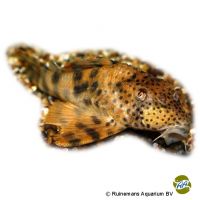Rondonia-Ancistomus L208 (Ancistomus sp. 'L208')
| Rondonia-Ancistomus L208 Ancistomus sp. 'L208' | |
|---|---|
| Name | Rondonia-Ancistomus L208 |
| Name Lat. | Ancistomus sp. 'L208' |
| Family | Suckermouth Armoured Catfishes |
| Family lat. | Loricariidae |
| Order | Catfishes |
| Order lat. | Siluriformes |
| Origin | Brazil |
| Habitat | Rivers |
| Diet | Omnivore, soft wood |
| pH | 5.0-8.0 |
| Behavior | Nocturnal, peaceful |
| Keeping | Individual, pair, harem |
| Care Level | Difficult |
| Reproduction | Cave spawner |
| Breeding | Difficult |
| Life Span | 5-8 years |
| Protection | No |
| Metric Units | |
| Size | 15 cm |
| Temperature | 23-27 °C |
| Hardness | 2-15 °dH |
| Aquarium | ~ 250 l |
| US Units | |
| Size | 6" |
| Temperature | 73-81 °F |
| Hardness | 36-267 ppm |
| Aquarium | ~ 65 gal |
Distribution and habitat
The distribution area of the Orangefin Fritillary Catfish L208 is the Rio Jaciparana in the Brazilian state of Rondonia. They prefer to stay in river sections with stones and dead wood.
Maintenance
The aquarium should have a robust planting, with stones and caves (catfish burrows) and roots that provide hiding places and at the same time are part of their diet. A round-grained substrate, subdued light (floating plants) and a weak current are ideal.
No ammonia, ammonium and nitrite should be detectable, the nitrate value should not exceed 100 mg/l. To ensure the water quality and oxygen content, a filter and heater adapted to the aquarium size is required, as well as lighting for the species-appropriate day-night rhythm of the animals.
Diet
They feed on plant and animal food. For a balanced diet, feed once a day with a high-quality dry food for loricariid catfish (granules, pellets, chips, tablets), supplemented with algae leaves, soft wood and fresh vegetables, such as zucchini, broccoli, bruised peas, scalded spinach, as well as zoopankton, cyclops, daphnia, artemia, mosquito larvae, shrimp, etc. (live or frozen)
Feed only as much as will be eaten within a few minutes, excluding plant foods. Regular and varied feeding promotes health and increases resistance.
Behaviour and compatibility
Orangefinned Fritillary Catfish are crepuscular and nocturnal. They sometimes behave intra-species territorial, so multiple animals should be kept only in large and richly structured tanks. They are very peaceful towards other fish and can be socialized well with them.
Basically, only compatible fish species with similar demands on water quality and water temperature should be socialized.
Sex dimorphism
Sexually mature males possess significantly longer gill cover spines (interopercular odontodes) than females.
Reproduction and breeding
There are only isolated reports of successful breeding in the aquarium. They are cave breeders and the male does the brood care.
Important
In dim light, the bright fin fringe turns bright orange
When catching, use as fine-meshed nets as possible so that the hard rays of the pectoral fins or the skin teeth (odontodes) do not get caught on the bone plates, which can cause painful stinging injuries when touched.
The well-being of the fish should be checked regularly. Temperature should be checked daily, pH, hardness and nitrate levels at least every 14 days. Regular partial water changes are recommended, even when contaminant levels have not yet reached the upper limit. Sudden changes in water quality should be avoided. Newly introduced fish must be accustomed slowly to the water in the aquarium.
Further literature can be found in your pet store.
References
Text: Sylvia Hos; Image: Ruinemans Aquarium B.V.
Source: BMELV (1998): Tierschutzgutachten - Haltung von Zierfischen (Süßwasser); ENGELMANN (2005): Zootierhaltung - Tiere in menschlicher Obhut: Fische, Verlag Harri Deutsch; SCHMIDT, WERNER, LECHNER (2005): MiniAtlas L-Welse, Bede Verlag
- Gemäß § 21 Abs. 5 Tierschutzgesetz idgF
